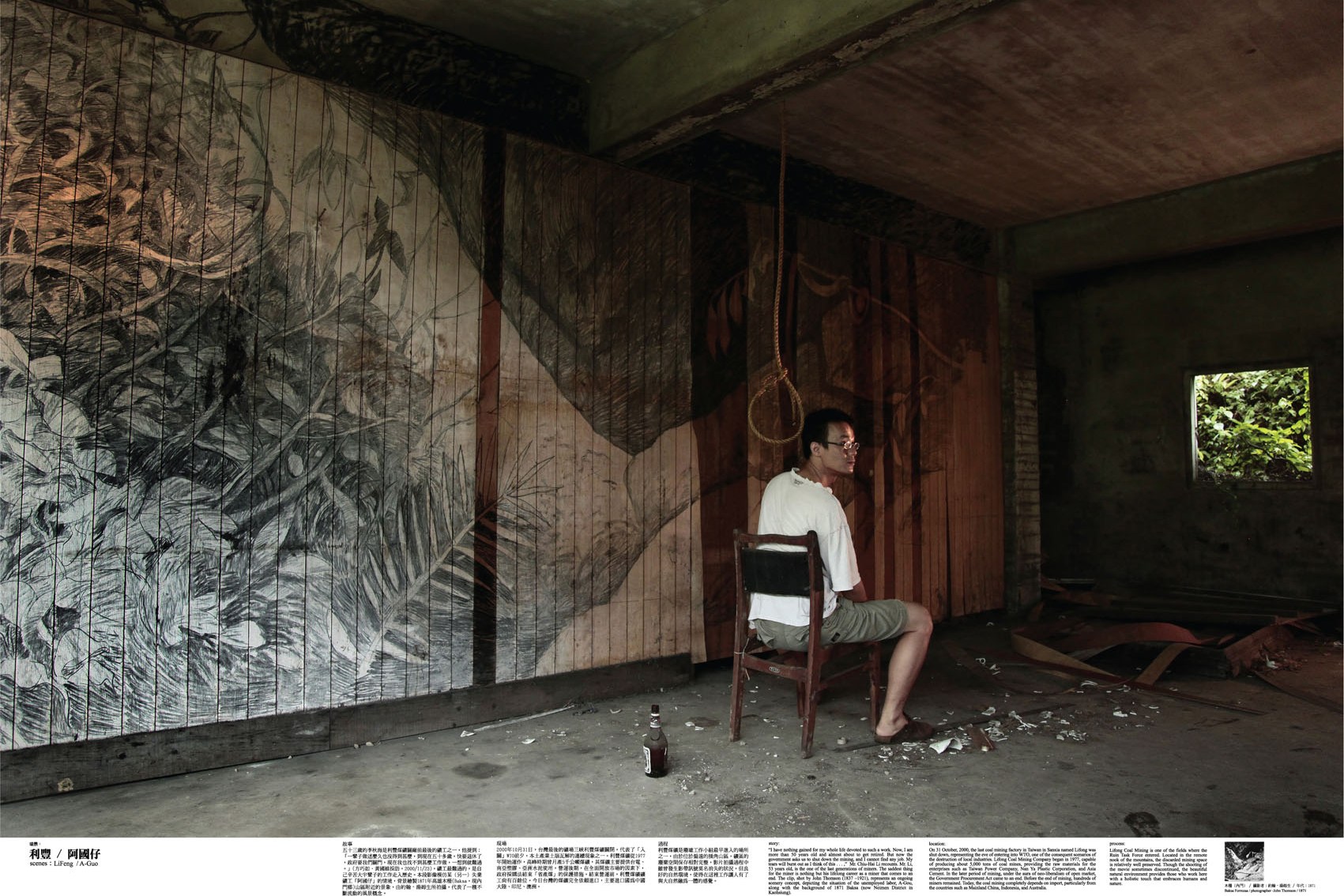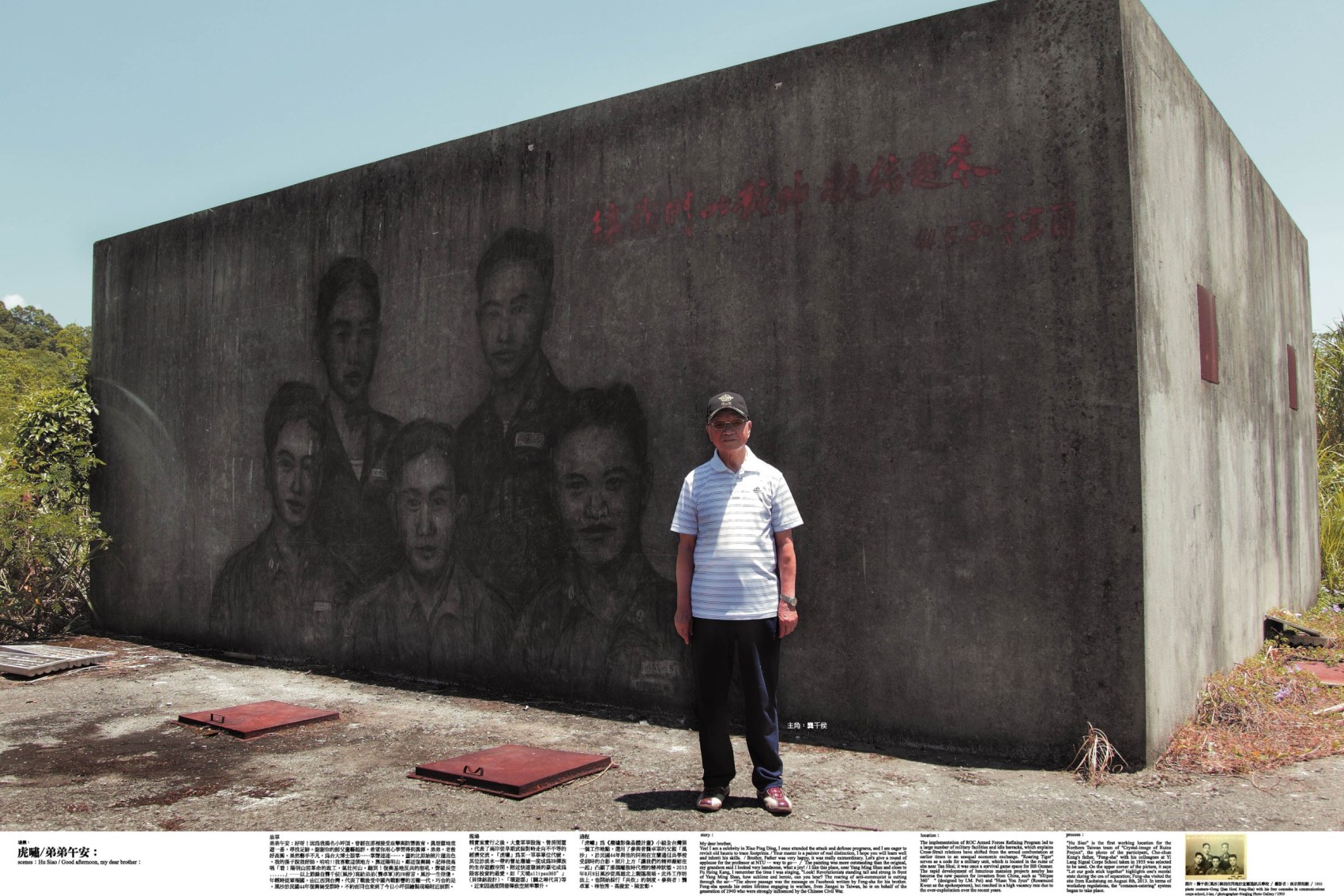高俊宏以在地歷史縱深的視角展開《廢墟影像晶體計畫》,以台灣直接、間接受1980年
KAO Jun-Honn's The Ruin Image Crystal Project: 10 Scenes was developed from a profound perspective on local history with serious depth and breadth. The project is based on historic images of neoliberalism in Taiwan after 1980. The significance of the work lies in the camps where he personally dwelled based on old photos of the sites. His methodology comprises ruin site research, excavation of archival documents, and the re-presentation and reenactment of historical photos. He has so far completed work on 10 sites and plans to continue. His ultimate goal is to physically act out and aestheticize the intersecting fields, casting anew the problems of neoliberalism in Taiwan. The works include the video Refraction of Li-Fong Coal Mine, in which the artist performed an art action in which he put on and removed 73 miners' work uniforms that were obtained from the ruins of Li-Fong coal mine, which in 2001 became the very last coal mine to close due to Taiwan's participation in the World Trade Organization. At the 2013 Asian Art Biennial, the artist's live performances combined various forms of art, such as records, actions, interviews, theatrical plays, and photographs.
高俊宏 KAO Jun-Honn
1973年出生於台北。藝術關注議題包括歷史、諸眾、空間、生命政治、新自由主義、社
龔卓軍、高俊宏、林怡秀、邱俊達、王鼎元等人
關鍵字
- 素描
- 表演
- 蔡明亮
- 照片
- 歷史
- 再現
- 自由貿易
- 資本主義
- 廢墟
- 災難
- live
- art
- 紀錄
- 行動
- 訪談
- 攝影
藝術家談作品
廢墟史,也是一部台灣自由經濟史。
廢墟史,也是一部台灣自由經濟史。
評審談作品
現代台灣從殖民時期到後殖民的轉印浮顯,在攝影影像與文字的互文存證下,展現其間遭忘卻、被扭曲的遺跡事物。
入圍理由 Reason for Nomination
以深具在地歷史縱深的視角而展開長期的地理踏查,《廢墟 晶體影像計畫》的意義在於親身駐點的營居,並依據該處或曾有的舊照片為摹本在牆上進行素描,或安排人物在廢墟現場的演出,是現代台灣從殖民時期到後殖民的轉印浮顯,在攝影影像與文字的互文存證下,拾起其間遺落的、受傷的、遁入過往而遭到忘卻的遺跡事物,邀請觀者去醒覺、甚至去探訪這一系列地點的歷史反思。饒富意義的是在本屆國美館「亞洲藝術雙年展」的展出中,高俊宏以live art的親身演出,這裏的歷史感橫跨紀錄、行動、訪談、劇演與攝影等諸多形式,從個人的體悟到與他人相聚的社會實踐,展現了感知強度與這個計畫豐富的美學面向。提名觀察人 ─ 陳泰松
A long-term survey on geography from a profound local historic perspective, the significance of “The Ruin Image Crystal Project: 10 Scenes” lies in the onsite camps, and the paintings on the wall based on old photos of the sites, or the performances arranged to be held onsite. This is the transcribed manifestation of Taiwan’s transition from colonial period to post-colonial era; with inter-witnessing of photographic images and texts, the lost, hurt, hidden in the past and forgotten heritages are picked up, inviting viewers to wake up, or to explore and visit these places and reflect on the history. What is more intriguing is that at this year’s “Asian Art Biennial”, KAO Jun-Honn performed live himself. Here, the sense of history transcends all forms, such as records, actions, interviews, theatrical plays, and photographs; from personal realization to joint social practice with others, all aspects display the perceptive strengths, as well as the rich aesthetic dimensions of this project. Nominators: CHEN Tai-Song
年度入選獎得獎理由 Reasons for being Shortlisted
高俊宏以在地歷史縱深的視角展開《廢墟影像晶體計畫》,意義在於親身駐點的營居,並依據該處曾有的舊照片為摹本。在牆上進行素描,或安排人物的演出,是現代台灣從殖民時期到後殖民的轉印浮顯,在攝影影像與文字的互文存證下,展現其間遭忘卻、被扭曲的遺跡事物。此計劃邀請觀者去記取、探訪十個地點的歷史反思。在本屆國美館「亞洲藝術雙年展」的展出中,藝術家以live art的親身演出,橫跨紀錄、行動、訪談、劇演與攝影,從個人的體悟到與他人相聚的社會實踐,展現了感知強度與這個計畫豐富的美學面向。複選委員 ─ 陳泰松、林于竝、邱坤良、阮慶岳、林曼麗、陳昌仁、陳郁秀、石瑞仁、吳靜吉
KAO Jun-Honn develops “The Ruin Image Crystal Project: 10 Scenes” from a profound local historic perspective with significant depth and breadth; the significance lies in the camps he dwelled in based on old photos of the sites. The sketches on the walls and arranged performances onsite are transcribed manifestation of modern Taiwan’s transition from colonial period to post-colonial era; with inter-witnessing of photographic images and texts, the twisted and forgotten heritages are displayed. The exhibition invites viewers to access and explore historic reflections of the ten sites. At this year’s “Asian Art Biennial”, KAO Jun-Honn’s live art combined various forms of art, such as records, actions, interviews, theatrical plays, and photographs. From personal realization to joint social practice with others, all aspects display the perceptive strengths as well as the rich aesthetic dimensions of this project. Semi-selection jury: CHEN Tai-Song, LIN Yu-Pin, CHIU Kun-Liang, ROAN Ching-Yueh, CHEN Chan-Jen, CHEN Yu-Hsiu, SHIH Jui-jen, LIN Man-Li, WU Jing-Jyi






